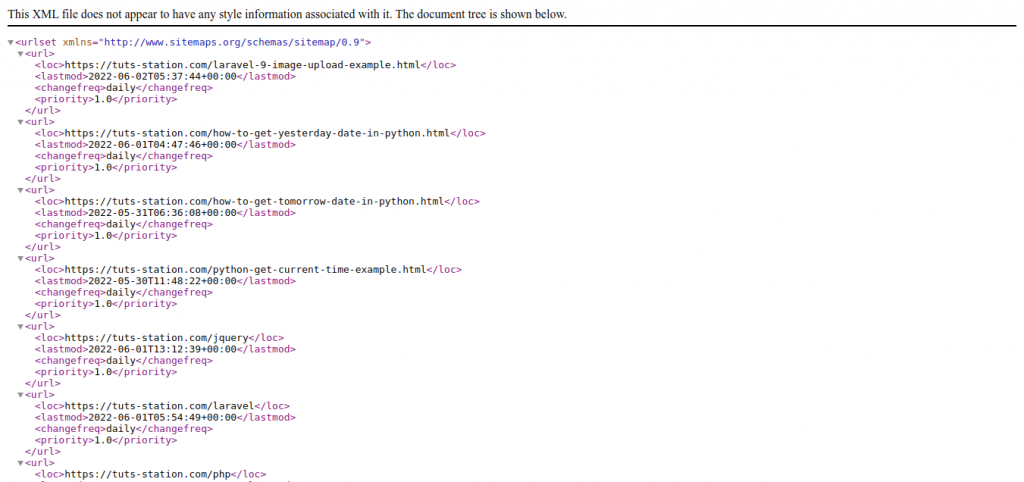本文重点介绍 laravel 9 生成站点地图。
我简单解释了 laravel 9 生成站点地图自定义。
我逐步解释了如何在 laravel 9 中创建动态 xml 站点地图。
我将向您展示有关 laravel 9 站点地图 xml 的信息。
基本上,理想情况下,站点地图是以 .xml 扩展名结尾的文件;它是一个简单的文件,其中包含重要的网站页面,并允许网站管理员通知搜索引擎哪些页面可供抓取。
无论您使用什么技术,此站点地图文件不仅限于 laravel,而且确保您必须生成并添加站点地图 xml 文件以通知搜索引擎。
让我们开始下面的例子:
第 1 步:安装 Laravel
首先,我们将从头开始新的 laravel 应用程序。如果您已经创建了项目,则跳过以下步骤。
composer create-project laravel/laravel example-app
第 2 步:创建迁移后和模型
在第二步中,我们需要通过以下命令创建一个新的迁移后模型:
php artisan make:migration create_posts_table
database/migrations/create_posts_table.php
<?php
use Illuminate\Database\Migrations\Migration;
use Illuminate\Database\Schema\Blueprint;
use Illuminate\Support\Facades\Schema;
return new class extends Migration
{
/**
* Run the migrations.
*
* @return void
*/
public function up()
{
Schema::create('posts', function (Blueprint $table) {
$table->id();
$table->string('title');
$table->string('slug');
$table->text('body');
$table->timestamps();
});
}
/**
* Reverse the migrations.
*
* @return void
*/
public function down()
{
Schema::dropIfExists('posts');
}
};现在按照以下命令运行迁移:
php artisan migrate
现在,运行以下命令来创建 Post 模型。
php artisan make:model Post
因此,然后将以下代码更新为 Post 模型。app/Models/Post.php
<?php
namespace App\Models;
use Illuminate\Database\Eloquent\Factories\HasFactory;
use Illuminate\Database\Eloquent\Model;
class Post extends Model
{
use HasFactory;
protected $fillable = [
'title', 'slug', 'body'
];
}第 3 步:创建后期工厂
然后,我们将创建 Post 工厂类并使用 tinker 命令生成虚拟记录。所以让我们运行下面的命令来创建后期工厂。
php artisan make:factory PostFactory
database/factories/PostFactory.php
<?php
namespace Database\Factories;
use Illuminate\Database\Eloquent\Factories\Factory;
use App\Models\Post;
use Illuminate\Support\Str;
/**
* @extends \Illuminate\Database\Eloquent\Factories\Factory<\App\Models\Post>
*/
class PostFactory extends Factory
{
/**
* The name of the factory's corresponding model.
*
* @var string
*/
protected $model = Post::class;
/**
* Define the model's default state.
*
* @return array
*/
public function definition()
{
return [
'title' => $this->faker->text(),
'slug' => Str::slug($this->faker->text()),
'body' => $this->faker->paragraph()
];
}
}然后只需运行 tinker 命令并创建虚拟帖子。
php artisan tinker
App\Models\Post::factory()->count(30)->create();
第 4 步:创建路线
routes/web.php
<?php
use Illuminate\Support\Facades\Route;
use App\Http\Controllers\SitemapController;
/*
|--------------------------------------------------------------------------
| Web Routes
|--------------------------------------------------------------------------
|
| Here is where you can register web routes for your application. These
| routes are loaded by the RouteServiceProvider within a group which
| contains the "web" middleware group. Now create something great!
|
*/
Route::get('sitemap.xml', [SitemapController::class, 'index']);第 5 步:创建新控制器
在第二步中,我们需要创建一个新的 SitemapController;在这个文件中,我们将为渲染视图和存储图像逻辑添加两个方法 index() 和 store()。
让我们通过以下命令创建 SitemapController:
php artisan make:controller SitemapController
app/Http/Controllers/SitemapController.php
<?php
namespace App\Http\Controllers;
use Illuminate\Http\Request;
use App\Models\Post;
class SitemapController extends Controller
{
/**
* Write code on Method
*
* @return response()
*/
public function index($value='')
{
$posts = Post::latest()->get();
return response()->view('sitemap', [
'posts' => $posts
])->header('Content-Type', 'text/xml');
}
}第 6 步:创建Blade文件
在最后一节中,我们需要使用 sitemap.blade.php 来显示所有帖子并输入以下代码:resources/views/sitemap.blade.php
<?php echo '<?xml version="1.0" encoding="UTF-8"?>'; ?>
<urlset xmlns="http://www.sitemaps.org/schemas/sitemap/0.9">
@foreach ($posts as $post)
<url>
<loc>{{ url('/') }}/post/{{ $post->slug }}</loc>
<lastmod>{{ $post->created_at->tz('UTC')->toAtomString() }}</lastmod>
<changefreq>daily</changefreq>
<priority>0.8</priority>
</url>
@endforeach
</urlset>运行 Laravel 应用程序:
所有步骤都已完成,现在您必须输入给定的命令并按回车键来运行 laravel 应用程序:
php artisan serve
现在,转到您的网络浏览器,输入给定的 URL 并查看应用程序输出:
http://localhost:8000/sitemap.xml
输出 :

我希望它可以帮助你…





